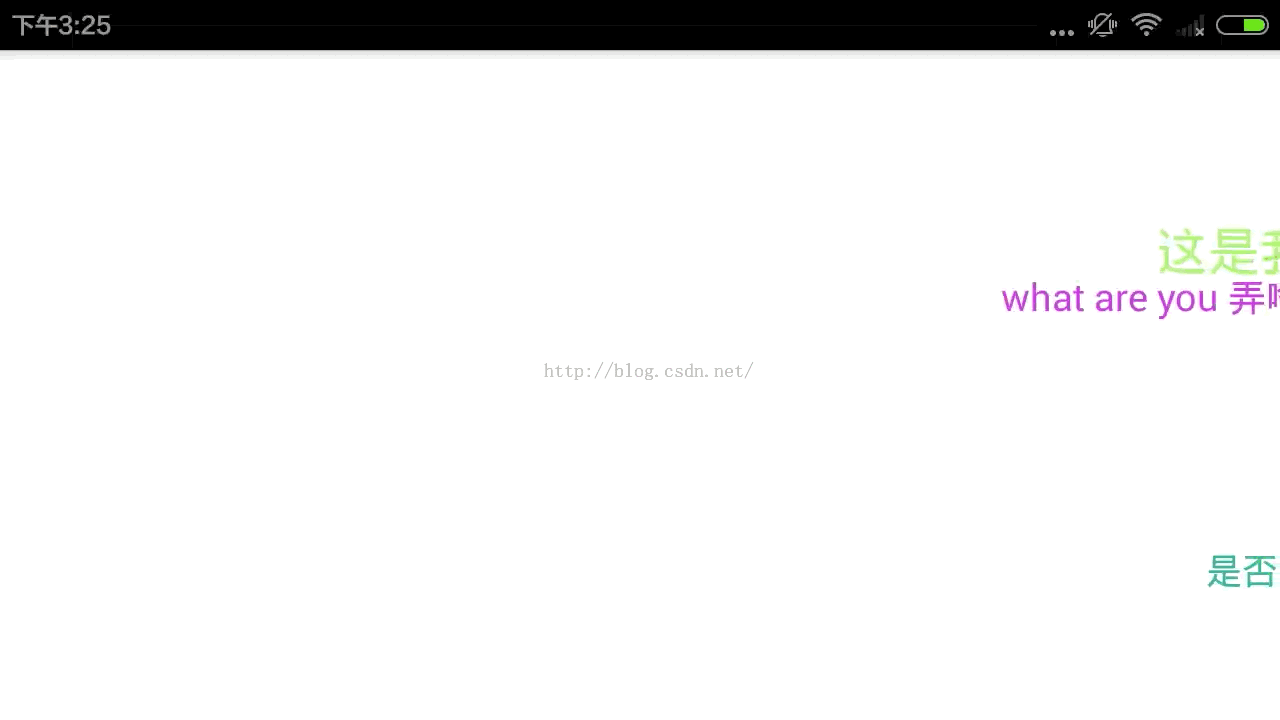
- Android中ExpandableListView的用法实例
- Android简单实现启动画面的方法
- android USB如何修改VID具体实现
- Android实现分享微信好友及出现闪退的解决办法
- Android TreeView效果实现方法(附demo源码下载)
- Android中通知Notification使用实例(振动、灯光、声音)
- ListView 分页加载更新实例分享
- Android多功能时钟开发案例(基础篇)
- 超好看的下拉刷新动画Android代码实现
- Android编程中号码匹配位数修改的方法
- Android仿QQ空间主页面的实现
- Android调用手机拍照功能的方法
- Android zip文件下载和解压实例
- Android中自定义View实现圆环等待及相关的音量调节效果
- 解决video标签在安卓webview下无法自动播放问题
- Android编程判断网络连接是否可用的方法
- Android学习笔记(二)之电话拨号器
- 详解Android应用中preference首选项的编写方法
- Android读取用户号码,手机串号,SIM卡序列号的实现代码
- 安卓(android)怎么实现下拉刷新
- android实现listview分页的方法
- android RadioGroup的使用方法
- 理解Android系统Binder机制
- Android中RecyclerView点击Item设置事件
- Android手势滑动实现两点触摸缩放图片
- 基于Android中dp和px之间进行转换的实现代码
- Android中ListView异步加载图片错位、重复、闪烁问题分析及解决方案
- Android 静默方式实现批量安装卸载应用程序的深入分析
- Android实现静态广播监听器的方法
- Android实现定制桌面的方法
实例解析如何在Android应用中实现弹幕动画效果
在B站或者其他视频网站看视频时,常常会打开弹幕效果,边看节目边看大家的吐槽。弹幕看起来很有意思,今天我们就来实现一个简单的弹幕效果。

从直观上,弹幕效果就是在一个ViewGroup上增加一些View,然后让这些View移动起来。所以,整体的实现思路大概是这样的:
1、定义一个RelativeLayout,在里面动态添加TextView。
2、这些TextView的字体大小、颜色、移动速度、初始位置都是随机的。
3、将TextView添加到RelativeLayout的右边缘,每隔一段时间添加一个。
4、对每个TextView做平移动画,使得TextView从右向左移动。
5、当TextView从左边移动出屏幕,将TextView从RelativeLayout中移除。
有了思路下面就来看具体的代码。
首先定义BarrageItem,用来存储每一个弹幕项的相关信息,包括字体内容、字体大小颜色、移动速度、垂直方向的位置、字体占据的宽度等。
public class BarrageItem {
public TextView textView;
public int textColor;
public String text;
public int textSize;
public int moveSpeed;//移动速度
public int verticalPos;//垂直方向显示的位置
public int textMeasuredWidth;//字体显示占据的宽度
}
然后定义BarrageView,由于弹幕的字体颜色大小和移动速度都是随机的,需要定义最大最小值来限定它们的范围,然后通过产生随机数来设置它们在这个范围内的值。另外还需要定义弹幕的文本内容,这里是直接写死的一些固定值。
private Context mContext;
private BarrageHandler mHandler = new BarrageHandler();
private Random random = new Random(System.currentTimeMillis());
private static final long BARRAGE_GAP_MIN_DURATION = 1000;//两个弹幕的最小间隔时间
private static final long BARRAGE_GAP_MAX_DURATION = 2000;//两个弹幕的最大间隔时间
private int maxSpeed = 10000;//速度,ms
private int minSpeed = 5000;//速度,ms
private int maxSize = 30;//文字大小,dp
private int minSize = 15;//文字大小,dp
private int totalHeight = 0;
private int lineHeight = 0;//每一行弹幕的高度
private int totalLine = 0;//弹幕的行数
private String[] itemText = {"是否需要帮忙", "what are you 弄啥来", "哈哈哈哈哈哈哈", "抢占沙发。。。。。。", "************", "是否需要帮忙","我不会轻易的狗带", "嘿嘿", "这是我见过的最长长长长长长长长长长长的评论"};
private int textCount;
// private List<BarrageItem> itemList = new ArrayList<BarrageItem>();
public BarrageView(Context context) {
this(context, null);
}
public BarrageView(Context context, AttributeSet attrs) {
this(context, attrs, 0);
}
public BarrageView(Context context, AttributeSet attrs, int defStyleAttr) {
super(context, attrs, defStyleAttr);
mContext = context;
init();
}
如果弹幕显示的垂直位置是随机的,就会出现垂直方向上弹幕重叠的情况,所以需要根据高度对垂直方向按照弹幕高度的最大值等分,然后让弹幕在这些指定的垂直位置随机分布。这个值在onWindowFocusChanged里计算,因为在这个方法中通过View的getMeasuredHeight()得到的高度不为空。
@Override
public void onWindowFocusChanged(boolean hasWindowFocus) {
super.onWindowFocusChanged(hasWindowFocus);
totalHeight = getMeasuredHeight();
lineHeight = getLineHeight();
totalLine = totalHeight / lineHeight;
}
通过Handler的sendEmptyMessageDelayed每隔随机的时间产生一个弹幕项。下面的代码设置弹幕项的属性。
class BarrageHandler extends Handler {
@Override
public void handleMessage(Message msg) {
super.handleMessage(msg);
generateItem();
//每个弹幕产生的间隔时间随机
int duration = (int) ((BARRAGE_GAP_MAX_DURATION - BARRAGE_GAP_MIN_DURATION) * Math.random());
this.sendEmptyMessageDelayed(0, duration);
}
}
private void generateItem() {
BarrageItem item = new BarrageItem();
String tx = itemText[(int) (Math.random() * textCount)];
int sz = (int) (minSize + (maxSize - minSize) * Math.random());
item.textView = new TextView(mContext);
item.textView.setText(tx);
item.textView.setTextSize(sz);
item.textView.setTextColor(Color.rgb(random.nextInt(256), random.nextInt(256), random.nextInt(256)));
item.textMeasuredWidth = (int) getTextWidth(item, tx, sz);
item.moveSpeed = (int) (minSpeed + (maxSpeed - minSpeed) * Math.random());
if (totalLine == 0) {
totalHeight = getMeasuredHeight();
lineHeight = getLineHeight();
totalLine = totalHeight / lineHeight;
}
item.verticalPos = random.nextInt(totalLine) * lineHeight;
showBarrageItem(item);
}
将每一个弹幕项添加到视图上,并给View添加一个TranslateAnimation动画,当动画结束时,将View从视图上移除。
private void showBarrageItem(final BarrageItem item) {
int leftMargin = this.getRight() - this.getLeft() - this.getPaddingLeft();
LayoutParams params = new LayoutParams(LayoutParams.WRAP_CONTENT, LayoutParams.WRAP_CONTENT);
params.addRule(RelativeLayout.ALIGN_PARENT_TOP);
params.topMargin = item.verticalPos;
this.addView(item.textView, params);
Animation anim = generateTranslateAnim(item, leftMargin);
anim.setAnimationListener(new Animation.AnimationListener() {
@Override
public void onAnimationStart(Animation animation) {
}
@Override
public void onAnimationEnd(Animation animation) {
item.textView.clearAnimation();
BarrageView.this.removeView(item.textView);
}
@Override
public void onAnimationRepeat(Animation animation) {
}
});
item.textView.startAnimation(anim);
}
private TranslateAnimation generateTranslateAnim(BarrageItem item, int leftMargin) {
TranslateAnimation anim = new TranslateAnimation(leftMargin, -item.textMeasuredWidth, 0, 0);
anim.setDuration(item.moveSpeed);
anim.setInterpolator(new AccelerateDecelerateInterpolator());
anim.setFillAfter(true);
return anim;
}
这样就完成了弹幕的功能,实现原理并不复杂。可以根据具体的需求来增加更多的控制,如控制每一行弹幕不重复,控制弹幕移动的Interpolator产生不同的滑动效果等等。
- 上一篇文章: 解析Android中Animation动画的编写要点
- 下一篇文章: 详解Android App卸载后跳转到指定的反馈页面的方法
- Android Touch事件分发过程详解
- Android App中实现简单的刮刮卡抽奖效果的实
- Android 动画之ScaleAnimation应用详解
- Android编程之杀毒的实现原理及具体实例
- Android自定义view实现圆形、圆角和椭圆图片
- Android源码学习之工厂方法模式应用及优势介
- Android控件之ScrollView用法实例分析